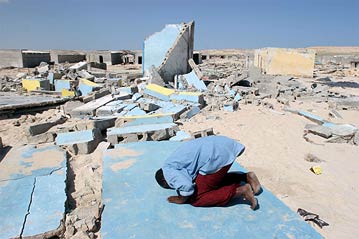UNHCR launches massive airlift for tsunami victims
UNHCR launches massive airlift for tsunami victims
2 January 2005
GENEVA - The first flight of the UN refugee agency's three-day, 400-tonne emergency airlift of shelter and relief supplies for the tsunami-battered Indonesian province of Aceh took off Sunday from Denmark. On the ground, UNHCR's logistics and supply teams started setting up advance bases in Sumatra to ensure rapid delivery of the aid, while the agency continued its round-the-clock relief operations in Sri Lanka.
A giant Antonov 124 jet freighter loaded with 100 tonnes of supplies left Billund airport in Denmark shortly after 8 a.m. local time Sunday. It was the first of five scheduled flights - four from Billund and one from Dubai - carrying shelter materials and basic living supplies for up to 100,000 people in Aceh, nearly a quarter of the affected population.
Sunday's first aircraft from Billund headed for Jakarta with 100 tonnes of plastic sheeting, blankets, kitchen sets and jerry cans from UNHCR's central warehouse in Copenhagen, as well as essential telecommunications equipment. Three further flights using Antonov 124s and an Ilyushin 76 are scheduled for Monday and Tuesday from Billund. A total of 20,000 plastic sheets, 100,000 blankets, 20,000 kitchen sets and 20,000 jerry cans from UNHCR's Copenhagen warehouse will be airlifted to Indonesia.
From Dubai, a Boeing 747 is scheduled to leave early Tuesday for Jakarta with 2,000 emergency 10-person tents from UNHCR's Mid-East stockpiles. That shipment will weigh more than 80 tonnes.
All of the 400 tonnes of relief materials from the airlift will be transferred from Jakarta to Medan by C-130 aircraft or shipped north to Sumatra by sea. UNHCR has an advance logistics and supply team on the ground in Banda Aceh and in the city of Medan to coordinate the arrival and distribution of the aid materials. In this first phase, UNHCR is deploying a 14-person emergency team to Aceh to reinforce the operation, and is also redeploying staff and vehicles from Jakarta and other parts of the Indonesian archipelago to northern Sumatra. Additional staff are being identified.
Some logistical constraints are being swept aside as private companies generously offer UNHCR free assistance and resources. The global express delivery company TNT (Global Express, Logistics and Mail) on Saturday offered free use of its fleet of trucks to transport the 400 tonnes of UNHCR aid from Medan to Banda Aceh. In Jakarta, DHL - a global delivery company - has offered free transit warehousing for all the relief items on UNHCR's airlift coming from Denmark this week.
In Sri Lanka, heavy rain is impeding UNHCR's ongoing round-the-clock distribution of emergency relief and shelter supplies in the war-affected east. There are reports that flooding is causing new displacement around Batticaloa. Since the day after the Dec. 26 tsunami, UNHCR has been using its existing relief stockpiles and established network of seven offices and 113 staff in Sri Lanka to distribute plastic sheeting, plastic mats, cooking sets and clothing to some 20,000 families in the tsunami-affected areas of Ampara, Batticaloa, Hambantota, Jaffna, Galle, Mullativu and Trincomalee. The refugee agency's existing supply stockpile, which played an important stopgap role while waiting for international aid to arrive, is expected to be depleted by the end of the coming week. Replenishment of stocks is underway with financial support from the Dutch non-governmental organisation, Stichting Vluchteling, which works closely with UNHCR on refugee programmes.
Five, huge portable warehouses of up to 1,000 cubic metres capacity each are expected to be airlifted into Sri Lanka shortly to expand UNHCR's warehousing capacity at its central stockpile in Colombo, as well as in other parts of the country. UNHCR is focusing its relief efforts in Sri Lanka on providing shelter.
UNHCR has been working for nearly 20 years in Sri Lanka, mainly in war-affected zones where before the tsunami it delivered humanitarian assistance and protection to some 390,000 returnees and internally displaced people. UNHCR estimates that since the tsunami, some 800,000 people can now be considered displaced. There are encouraging signs the Sri Lankan government and the LTTE - known as the Tamil Tigers - are jointly coordinating a response to the emergency in the war-affected areas, where UNHCR and the International Committee of the Red Cross have been long established delivering assistance.









